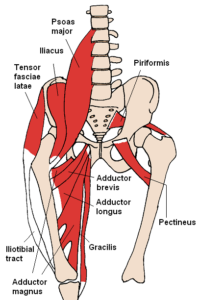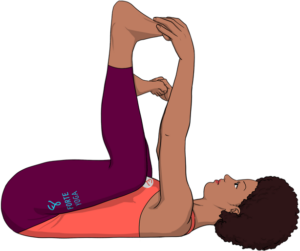When you get into your car, your legs split apart as your lead leg enters first, other leg still outside the door frame, and your inner thighs hurt.
Why is this?
One or both inner thighs may hurt as you’re getting into your car, and also out of it, triggered by when your legs spread apart.
“The inner thigh muscles are called the adductor muscle group,” says Dr. Megan McLain, PT, DPT, cofounder of Intuitive Choice Physical Therapy & Wellness in Atlanta, GA.
“They originate at various points along the front of the pelvis and attach along the inner thigh and some of them down below the knee.

Adductor muscle group. Beth ohara/CC BY-SA 3.0 creativecommons.orglicensesby-sa3.0
“This allows you to pull your legs together and also helps to provide stability to both the hip and knee during periods where we are standing on one leg, even briefly, like with walking, stairs, curbs, uneven ground, etc.
“If they are overly tight, then it can be difficult to separate your legs while you’re stepping into a car.
“This could be caused by an adductor strain on either one or both sides.
“These most commonly occur with rapidly changing direction during playing sports, taking off quickly while running, or slipping and trying to prevent yourself from falling into a split motion.
“This type of tightness could also be caused by problems with the lower back or hip arthritis as well.”
It’s also possible that you may have some tendonitis in a hip adductor, namely the iliapsoas group.
A tendon attaches muscle to bone. Tendonitis means the tendon is inflamed.
The inflammation would be from overuse or strain of the muscle, which would be transmitted to the tendon.
Iliapsoas tendonitis may come with a popping or snapping sound and/or popping sensation when you raise the knee or stand up after prolonged sitting.
Solutions for Pain in the Inner Thigh when Getting into and out of a Car
“It’s important to have an assessment performed to determine where the tightness is coming from,” says Dr. McLain.
“It might seem like stretching is the best solution, but depending on the source of the problem, it may not be the best move.
“If there is a strain, then stretching the healing muscle tissue could actually prolong healing.
“Tightness in muscles usually is masking an underlying weakness.
“For this reason, as long as the area is pain-free, it’s typically beneficial to strengthen the area to help with recovery as well as to prevent it from coming back in the future.
“Squeezing a pillow or Pilates ring between the knees is a simple way to start. Maintaining overall mobility in the hips is also important.

Pilates ring. Freepik.com/Senivpetro
“If you determine that you have adequate strength and mobility in the hips and are not dealing with an injury, one of my favorite adductor stretches is called the happy baby stretch.
“This is also a well-known yoga position. It can also help with relaxing the pelvic floor muscles.

Happy baby pose. You may not be able to go down this far; go down as far as you’re comfortable.
“Butterfly stretches are also effective. To truly lengthen tissue, you would need to hold at least four reps for 30 seconds.”

Butterfly stretch. Freepik.comwayhomestudio
Another exercise that may prove beneficial is that of standing erect with your feet far apart so that you’re just beginning to feel a slight pull in your inner thighs. Keep your toes pointed straight ahead at all times.
Hold for 30 seconds. See if you can widen your stance (keep legs straight, back upright — do not lean forward) just a little bit more. If so, hold again for 30 seconds.
Do not go so wide that you’re in pain or forced to bend forward. Do this exercise daily for three sets, beginning with a warmup and then progressing further out with the next two sets.
Another helpful tactic is to avoid spreading your legs when getting in and out of your car.
This can be done by first sitting on the seat with both feet outside the car, legs together, as though there’s superglue between your thighs.
Next, lift your feet off the ground, swiveling your legs — keeping them glued together — into the car, placing feet on the floor.
You just got into your car without stretching your adductors. You can also exit the same way.
Doing this as a habit will give your adductors a chance to heal from the stress of getting in and out of a car.
If the pain in your inner thighs doesn’t go away, a physical therapist can design a specific program for increasing strength and limberness.
 Dr. Megan McLain, PT, DPT, puts her clients first while providing one-on-one in-home care. With physical therapy and health coaching services, Dr. McLain addresses all aspects such as physical barriers, mindset, accountability and knowledge that may be impacting the client’s experience.
Dr. Megan McLain, PT, DPT, puts her clients first while providing one-on-one in-home care. With physical therapy and health coaching services, Dr. McLain addresses all aspects such as physical barriers, mindset, accountability and knowledge that may be impacting the client’s experience.
 Lorra Garrick has been covering medical, fitness and cybersecurity topics for many years, having written thousands of articles for print magazines and websites, including as a ghostwriter. She’s also a former ACE-certified personal trainer.
Lorra Garrick has been covering medical, fitness and cybersecurity topics for many years, having written thousands of articles for print magazines and websites, including as a ghostwriter. She’s also a former ACE-certified personal trainer.
.


























